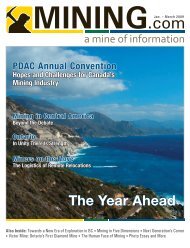You also want an ePaper? Increase the reach of your titles
YUMPU automatically turns print PDFs into web optimized ePapers that Google loves.
Environment & Communities<br />
Detail of the asbestos fibers into the stone.<br />
boiled with distilled water under a reflux<br />
condenser, they do not lose their color,<br />
thus indicating that the dye is chemically<br />
bound to the fiber. Table 1 gives the color<br />
of the dye solution and the color of the<br />
asbestos treated by these dyes.<br />
The appearance of new peaks in<br />
X-ray diffraction patterns and in infrared<br />
Asbestos and Asbestos Health<br />
Effects<br />
Asbestos substitutes<br />
Agency for Toxic Substances and<br />
Disease Registry’s Web site<br />
Cell toxicity, hemolytic action and<br />
clastogenic activity of asbestos<br />
and its substitutes<br />
Comparative studies on the cytotoxicity<br />
of amphibole and serpentine<br />
asbestos<br />
EPA Asbestos Bans<br />
Carter C.F. and Smith A.L.,<br />
Principles of Microbiology, Mosby,<br />
St Louis 1957<br />
Dodd C.G., in Clays and Clay<br />
Technology, Proceedings of the<br />
First National Conference, edited<br />
by J.A. Pask and M.D. Turner,<br />
Department of Natural Resources<br />
Bulletin 169, Division of Mines,<br />
Click here for full list of links: http://go.mining.<strong>com</strong>/sept08-a17<br />
60 <strong>MINING</strong>.<strong>com</strong> September 2008<br />
spectra, together with the absence of<br />
precipitates, supports the view that<br />
chelates are formed with asbestos, apparently<br />
with its Mg(OH) 2 <strong>com</strong>ponent.<br />
This resembles the process of mordant<br />
dyeing of textile fibers where Mg(OH) 2 ,<br />
Al(OH) 3 , or Cr(OH) 3 are first precipitated<br />
on textile fibers then known as “lakes”<br />
Links and References<br />
San Francisco, California, 1955<br />
pp. 105-11<br />
Somasundaran P. and Nagaraj<br />
D.R., in Reagents in the Mineral<br />
Industry, edited by M.J. Jones<br />
and R. Oblatt, Institution of Mining<br />
and Metallurgy, London, 1984, pp.<br />
209-19<br />
Fu E. and Somasundaran P., Int. J.<br />
Min. Processing 18 (1986) 287<br />
Khare S.K. et al., J. Chem. Tech. &<br />
Biotech. 38 (1987) 99<br />
Makhlouf M.Th. and Khalil Z.H., J.<br />
Chem. Tech. & Biotech. 38 (1987)<br />
89<br />
Giles C.H., Chem. Ind. (London)<br />
(1959) 1400<br />
Habashi F. et al., “Asbestos Fibers<br />
Modified with Organic Dyes”, Can.<br />
Patent, 1, 220, 492 (1988)<br />
[13]. Some organic <strong>com</strong>pounds, e.g.,<br />
bromocresol purple and phenolphthalein,<br />
although they are not dyestuffs,<br />
color asbestos. They have nearly similar<br />
structure and behave nearly the same<br />
way towards asbestos. The toxicity of<br />
the colored fibers was measured by the<br />
tests mentioned earlier and <strong>com</strong>pared<br />
with the uncolored sample. It was found<br />
that some dyes, e.g., Thiazol Yellow G<br />
and Trypan Blue decreased the toxicity<br />
of the fibers (Table 2).<br />
Chrysotile asbestos can be colored<br />
by a variety of dyes at ambient conditions<br />
like textile fibers forming stable magnesium<br />
chelates. Certain dyes render it<br />
less toxic as measured by the homolytic<br />
and cyto toxicity tests. This is a promising<br />
area of research that may lead to the<br />
preparation of colored asbestos that is<br />
nontoxic.<br />
Since the major application of asbestos,<br />
about 70%, is in the fabrication of<br />
asbestos cement whereby the fibers are<br />
slurried in water with Portland cement, the<br />
addition of a dye in this step is a simple<br />
matter. Colored asbestos is stable with<br />
respect to boiling water, which suggests<br />
a chemical reaction with magnesium hydroxide<br />
in the silicate structure.<br />
Habashi F. et al., “Surface<br />
Modification of Chrysotile<br />
Asbestos with Organic Reagents:<br />
A Preliminary in vitro Toxicological<br />
Study”, Bull. Can. Inst. Min. & Met.<br />
84 (945), 67-79 (1991)<br />
Awadalla F.T., Habashi F.,<br />
“Reaction of Chrystoile Asbestos<br />
with Triphenylmethane Dyes”, J.<br />
Materials Sci. 25, 87-92 (1990)<br />
Habashi F., “Dyeing of Asbestos<br />
Fibers”, Textile Chemist & Colorist<br />
24 (4), 23-25 (1992)<br />
Michaels L. and Chissick S.S.<br />
(editors), “Asbestos”, vols 1 and 2<br />
(Wiley, New York 1979)<br />
Trotman S.R. and Trotman E.R.,<br />
The Bleaching, Dyeing, and<br />
Chemical Technology of Textile<br />
Fibers, Giffin, London 1948




